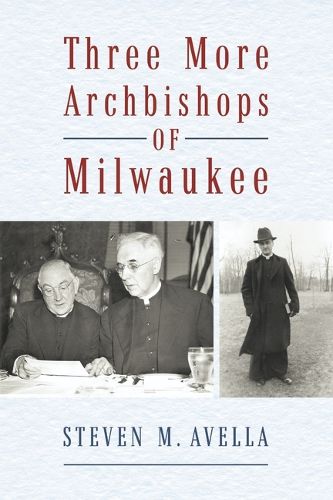Readings Newsletter
Become a Readings Member to make your shopping experience even easier.
Sign in or sign up for free!
You’re not far away from qualifying for FREE standard shipping within Australia
You’ve qualified for FREE standard shipping within Australia
The cart is loading…






"Three More Archbishops of Milwaukee" offers an in-depth look at three Catholic archbishops who guided Milwaukee's archdiocese from 1930 to 1958: Samuel A. Stritch, Moses E. Kiley, and Albert G. Meyer. Although each archbishop brought a distinct temperament and leadership style to their role, they shared a foundational education from Roman seminaries, which played a crucial part in shaping their vision and governance. Samuel A. Stritch, the first U.S.-born archbishop of Milwaukee, arrived as the Great Depression gripped Wisconsin. His leadership focused on stabilizing faltering archdiocesan finances and energizing lay Catholic Action. Stritch's pastoral touch and accessibility endeared him to Milwaukeeans, and his eventual departure for Chicago was widely lamented. His successor, Moses E. Kiley, a native of Nova Scotia, was a stern and taciturn figure. He focused on planning and rebuilding as Milwaukee prospered after World War II. Kiley's strict rule, particularly with clergy, was accompanied by efforts to rebuild a cathedral and enhance archdiocesan institutions, including the seminary and orphanage. Albert G. Meyer, who followed Kiley, had extensive ties to Wisconsin, having served as rector of St. Francis Seminary and bishop of Superior. His tenure was marked by rapid expansion of parishes and schools, and he oversaw the largest period of growth in the archdiocese's history. Meyer also confronted challenges brought by the freeway system, suburbanization, and the shifting racial demographics in Milwaukee.
Throughout their terms, all three archbishops brought a Roman-trained, uniform theological vision, providing a sense of continuity to Milwaukee Catholicism during a time of great transformation. Ethnic identities, though still important, began to fade in prominence as suburban life reshaped the community. Despite these shifts, the steady leadership of Stritch, Kiley, and Meyer offered stability and cohesion to Milwaukee Catholics in a period of immense social and institutional change.
$9.00 standard shipping within Australia
FREE standard shipping within Australia for orders over $100.00
Express & International shipping calculated at checkout
"Three More Archbishops of Milwaukee" offers an in-depth look at three Catholic archbishops who guided Milwaukee's archdiocese from 1930 to 1958: Samuel A. Stritch, Moses E. Kiley, and Albert G. Meyer. Although each archbishop brought a distinct temperament and leadership style to their role, they shared a foundational education from Roman seminaries, which played a crucial part in shaping their vision and governance. Samuel A. Stritch, the first U.S.-born archbishop of Milwaukee, arrived as the Great Depression gripped Wisconsin. His leadership focused on stabilizing faltering archdiocesan finances and energizing lay Catholic Action. Stritch's pastoral touch and accessibility endeared him to Milwaukeeans, and his eventual departure for Chicago was widely lamented. His successor, Moses E. Kiley, a native of Nova Scotia, was a stern and taciturn figure. He focused on planning and rebuilding as Milwaukee prospered after World War II. Kiley's strict rule, particularly with clergy, was accompanied by efforts to rebuild a cathedral and enhance archdiocesan institutions, including the seminary and orphanage. Albert G. Meyer, who followed Kiley, had extensive ties to Wisconsin, having served as rector of St. Francis Seminary and bishop of Superior. His tenure was marked by rapid expansion of parishes and schools, and he oversaw the largest period of growth in the archdiocese's history. Meyer also confronted challenges brought by the freeway system, suburbanization, and the shifting racial demographics in Milwaukee.
Throughout their terms, all three archbishops brought a Roman-trained, uniform theological vision, providing a sense of continuity to Milwaukee Catholicism during a time of great transformation. Ethnic identities, though still important, began to fade in prominence as suburban life reshaped the community. Despite these shifts, the steady leadership of Stritch, Kiley, and Meyer offered stability and cohesion to Milwaukee Catholics in a period of immense social and institutional change.